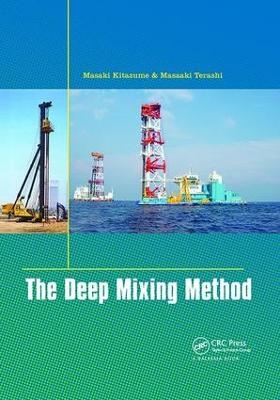
The Deep Mixing Method
CRC Press (Verlag)
978-1-138-07579-5 (ISBN)
Due to its wide applicability and high improvement effect, the method has become increasingly popular in many countries in Europe, Asia and in the USA. In the past three to four decades, traditional mechanical mixing has been improved to meet changing needs. New types of the technology have also been developed in the last 10 years; e.g. the high pressure injection mixing method and the method that combines mechanical mixing and high pressure injection mixing technologies. The design procedures for the DM methods were standardized across several organizations in Japan and revised several times. Information on these rapid developments will benefit those researchers and practitioners who are involved in ground improvement throughout the world.
The book presents the state of the art in Deep Mixing methods, and covers recent technologies, research activities and know-how in machinery, design, construction technology and quality control and assurance.
The Deep Mixing Method is a useful reference tool for engineers and researchers involved in DMM technology everywhere, regardless of local soil conditions and variety in applications.
Masaki Kitazume, Masaaki Terashi
CHAPTER 1 Overview of Ground Improvement – Evolution of Deep Mixing and Scope of the Book
1 Introduction
2 Classification of ground improvement technologies
3 Development of deep mixing in Japan - historical review
4 Diversified admixture stabilization techniques without compaction
5 Scope of the text
CHAPTER 2 Factors Affecting Strength Increase
1 Introduction
2 Influence of various factors on strength of lime stabilized soil
3 Influence of various factors on strength of cement stabilized soil
4 Prediction of strength
CHAPTER 3 Engineering Properties of Stabilized Soils
1 Introduction
2 Physical properties
3 Mechanical properties (strength characteristics)
4 Mechanical properties (consolidation characteristics)
5 environmental properties
6 Engineering properties of cement stabilized soil manufactured in situ
7 Summary
CHAPTER 4 Applications
1 Introduction
2 Patterns of applications
3 Improvement purposes and applications
4 Applications in Japan
5 Performance of improved ground in the 2011 Tohoku earthquake
CHAPTER 5 Execution - Equipment, Procedures and Control
1 Introduction
2 Classification of deep mixing techniques in Japan
3 Dry method of deep mixing for on-land works
4 Wet method of deep mixing for on-land works
5 Wet method of deep mixing for in-water works
6 Additional issues to be considered in mechanical mixing method
7 High pressure injection method
8 Combined technique
CHAPTER 6 Design of Improved Ground by Deep Mixing Method
1 Introduction
2 Engineering behavior of deep mixed ground
3 Work flow of deep mixing and design
4 Design Procedure for embankment support, group column type improved ground
5 Design procedure for block type and wall type improved grounds
6 Design procedure for block type and wall type improved grounds, reliability design
7 Design procedure for liquefaction prevention, grid type improved ground
CHAPTER 7 QC/QA for Improved Ground - Current Practice and Future Research Needs
1 Introduction
2 Flow of deep mixing project and QC/QA
3 QC/QA for stabilized soil – current practice
4 QC/QA of improved ground – research needs
5 Summary
APPENDIX A Japanese Laboratory Mix Test Procedure
1 Introduction
2 Testing equipment
3 Making and curing of specimens
4 Report
5 Use of specimens
| Erscheinungsdatum | 01.07.2017 |
|---|---|
| Verlagsort | London |
| Sprache | englisch |
| Maße | 174 x 246 mm |
| Gewicht | 453 g |
| Themenwelt | Technik ► Bauwesen |
| Technik ► Bergbau | |
| Technik ► Umwelttechnik / Biotechnologie | |
| ISBN-10 | 1-138-07579-5 / 1138075795 |
| ISBN-13 | 978-1-138-07579-5 / 9781138075795 |
| Zustand | Neuware |
| Informationen gemäß Produktsicherheitsverordnung (GPSR) | |
| Haben Sie eine Frage zum Produkt? |
aus dem Bereich


